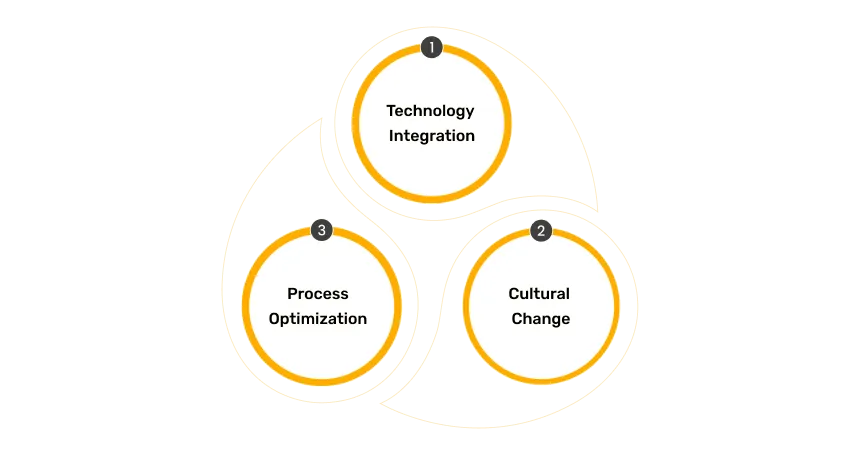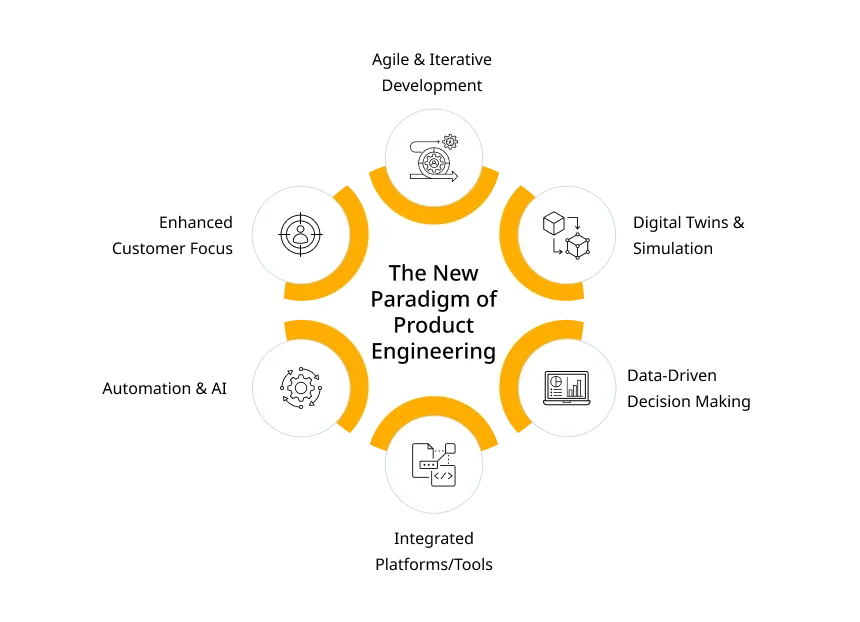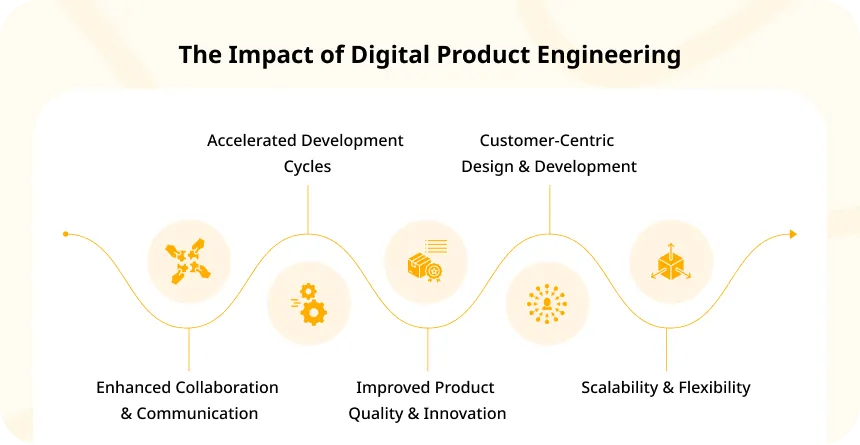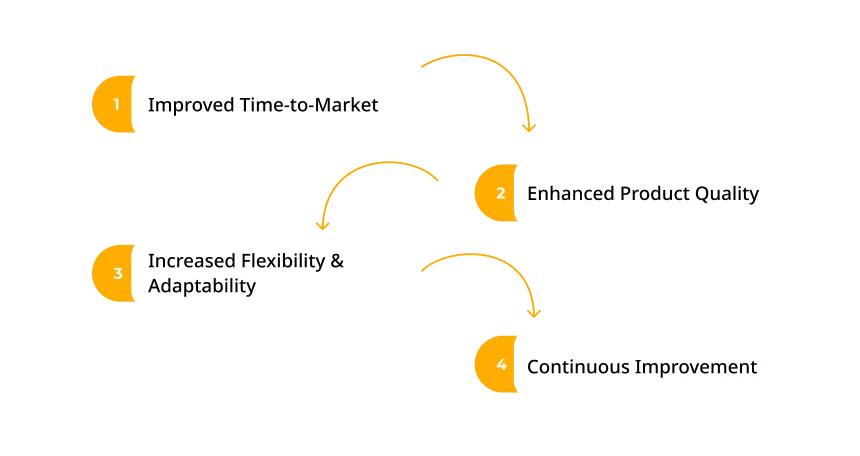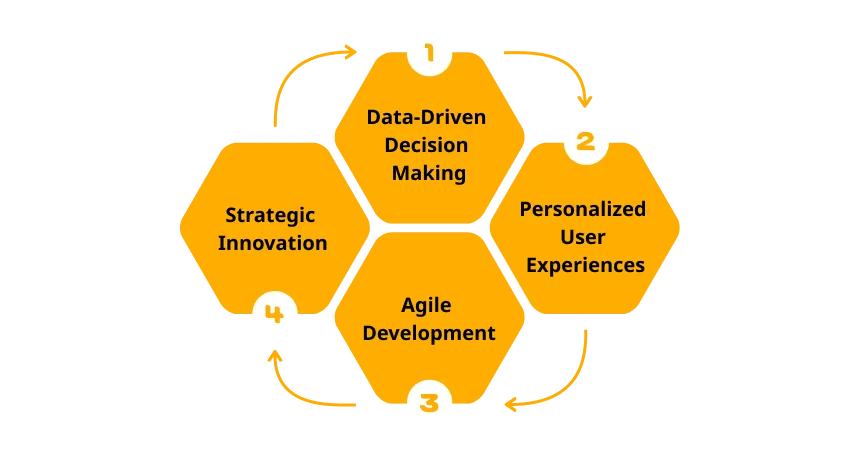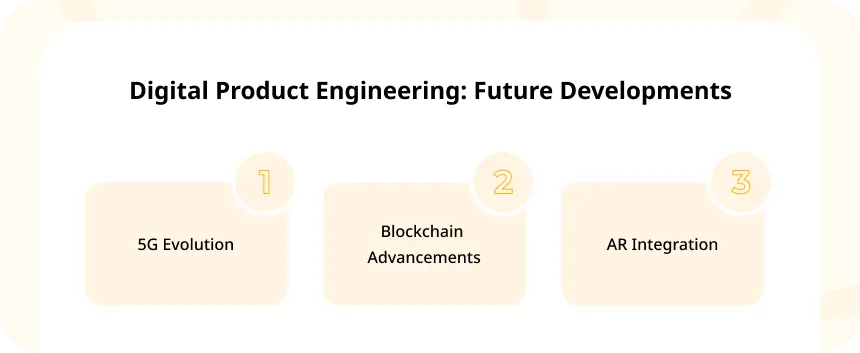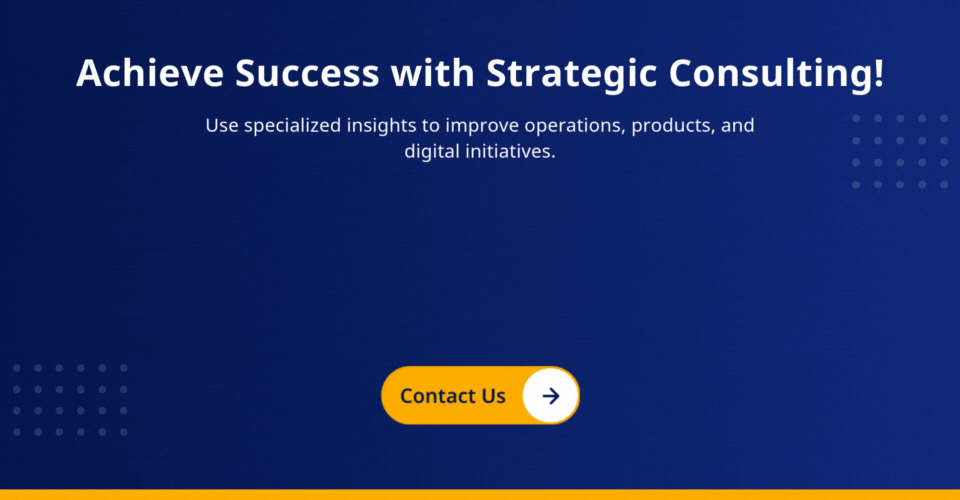Do you want to redefine your product engineering experience with digital transformation?
If yes, it will be worth reading this post for you & your business success.
Today, technology is moving fast, changing industries and making our lives different in exciting ways.
This big move is especially evident in product engineering, where innovative digital tools and methodologies are changing the way software products are developed.
So, check out our blog post on how technology is changing and improving digital products. We’ll discuss how these changes are making a big difference in the industry.
What is Digital Transformation?
Digital transformation can be defined as the comprehensive integration of digital technologies into all aspects of a software business. It is fundamentally changing how companies operate & deliver good value to customers.
It involves utilizing the following technologies to streamline processes, enhance decision-making, and foster innovation.
- Cloud computing
- Artificial Intelligence
- Internet of Things
- Big data analytics
For modern businesses, digital transformation services are not just about upgrading IT systems but about improving customer experiences, rethinking business models, and creating new avenues for growth & efficiency.
Digital Transformation Essentials
Digital transformation is defined as the continuous journey that requires continuous adaptation & innovation. Explore its various components as discussed below:
1. Technology Integration
The key behind digital transformation success is the seamless incorporation of advanced technologies into various business operations. This includes
- Adopting cloud-based solutions for scalability
- Utilizing AI/ML for data-driven insights
- Implementing IoT devices for real-time monitoring & control
The above technologies allow businesses to respond swiftly to market changes while operating more efficiently & innovate continuously.
Also read: Digital Transformation Essentials For Modern Businesses
2. Cultural Change
Successful digital transformation must need a shift in organizational culture. It generally demands a good mindset that
- Embraces change
- Encourages experimentation
- Fosters collaboration
Employees need to be empowered to use new tools and technologies effectively, and leadership must champion a culture of continuous improvement and agility. This cultural shift ensures that the organization can adapt to new challenges & opportunities presented by the digital landscape.
3. Process Optimization
Digital transformation carries reengineering business processes to utilize advanced technology for maximum efficiency & effectiveness. This includes
- Automating repetitive tasks
- Optimizing supply chain operations
- Enhancing customer interactions through digital channels
By refining the above processes, businesses can actually reduce costs, improve speed to market, and deliver higher quality products/services.
Embrace digital transformation for enhanced efficiency and innovation.
Top Reasons to Digitally Transform
In today’s fast-paced & highly competitive market, digital transformation is a need for businesses because of the following reasons:
1. Staying Competitive
Organizations that embrace digital transformation are well-positioned to innovate & differentiate themselves from competitors. They can immediately adapt to changing market conditions, thus, introducing new products/services that meet evolving customer needs more effectively.
2. Meeting Customer Expectations
Modern customers expect seamless, personalized experiences across all touchpoints. Digital transformation allows businesses to gather & analyze customer-centric solutions to provide tailored experiences. This further improves customer service & build stronger relationships.
3. Enhancing Efficiency & Agility
Optimizing processes & integrating advanced technologies can help businesses operate more efficiently and flexibly. This reduces operational costs and allows quicker responses to market trends and disruptions. This further ensures long-term sustainability & growth.
Hence, digital product engineering is important for creating smarter, more efficient, and more competitive products that meet the demands of a digital-first world.
Must Read: How MSMEs Can Benefit From Digital Business Practices
The Evolution of Product Engineering
The shift towards a digital product engineering innovation not only addresses the cons of traditional methods but also opens up new opportunities for innovation, efficiency, and competitiveness. Here is an overview of traditional product engineering methodologies:
1. Waterfall Model: It is a linear & sequential approach where each phase is completed first before moving to the next. Common in traditional engineering but often inflexible to change.
2. Manual Design & Prototyping: Reliance on physical prototypes & manual drafting processes. These are time-consuming and costly.
3. Limited Data Utilization: Engineering decisions based on limited data, often from physical tests & historical performance rather than real-time analytics.
4. Isolated Development Stages: Different stages of product development (design, testing, manufacturing etc.) operate in silos. This leads to inefficiencies & communication errors.
Challenges Faced in Traditional Product Engineering Approaches
1. Lack of Flexibility: Traditional methodologies are often rigid. This makes it difficult to accommodate changes in design or customer requirements mid-process.
2. Time-Consuming Processes: Manual methods and sequential workflows significantly delay time-to-market.
3. High Costs: Physical prototyping & extensive testing phases incur substantial costs.
4. Inefficient Collaboration: Siloed departments and lack of integrated communication tools hinder collaboration & innovation.
5. Limited Scalability: Difficulty in scaling operations to meet increasing demand or incorporating new technologies quickly.
New Paradigm of Product Engineering
As digital transformation continues to evolve, the landscape of digital product engineering will expand too. This will drive the industry towards a smarter and more connected future. Here is the new paradigm of product engineering driven by digital transformation:
1. Agile & Iterative Development: Embracing agile methodologies allows for iterative development and continuously improving products based on feedback/data.
2. Digital Twins & Simulation: Utilizing digital twins to create virtual replicas of physical products for simulation and testing. This reduces the need for physical prototypes.
3. Data-Driven Decision Making: Leveraging big data & analytics to make informed decisions throughout the product lifecycle, from design to manufacturing.
4. Integrated Platforms/Tools: Adopting integrated software platforms that facilitate seamless collaboration between design, engineering, and production teams.
5. Automation & AI: Incorporating automation & artificial intelligence to reduce errors, streamline processes, and enhance efficiency.
6. Enhanced Customer Focus: Using digital tools to gather customer feedback in real-time. This allows products to meet market demands & expectations.
Harness the power of AI and IoT in product development
How Digital Transformation Impacts Product Engineering?
As we know, digital transformation has profoundly reshaped the landscape of product engineering, influencing every stage from design to deployment.
Digital product engineering is driving significant changes in product engineering, making processes more efficient, collaborative, and innovative.
By utilizing advanced digital tools & methodologies, businesses can further accelerate their product development cycles, improve quality, and stay competitive in the ever-evolving market.
1. Enhanced Collaboration & Communication
Digital product engineering has significantly enhanced collaboration & communication within organization. The software integration of advanced digital tools has
- Streamlined workflows
- Bridged geographical gaps
- Fostered more collaborative work environment
Digital tools facilitate real-time communication & information sharing among team members, regardless of their physical location. These tools enable seamless collaboration on complex projects, thus, ensuring that all team members are on the same page and can contribute effectively.
Examples of Collaboration Platforms
1. Slack: It is well-known messaging platform that supports team collaboration via direct messaging, channels, and integration using other productivity tools.
2. Asana: It is a good project management tool that helps teams organize, track, and manage their work.
3. JIRA: It is a widely used tool for agile project management and issue tracking.
4. Microsoft Teams: It integrates easily with other Microsoft Office 365 apps, thus, facilitating collaboration on documents, spreadsheets, and presentations.
2) Accelerated Development Cycles
Digital transformation accelerates development cycles through the implementation of Agile and DevOps methodologies. By embracing these methodologies, digital product engineering teams can stay agile and competitive in an ever-evolving digital landscape. Here is an overview of Agile and DevOps methodologies:
Agile Methodology
Agile is a flexible & iterative approach to software development that emphasizes collaboration, customer feedback, and small, rapid releases.
By breaking projects into smaller, manageable units called sprints, Agile enables teams to deliver functional parts of the product incrementally, allowing for continuous improvement and adaptation based on user feedback & changing requirements.
DevOps Practices
DevOps bridges the gap between development & operations teams, thus, spreading a culture of collaboration and shared responsibility.
Key practices include continuous integration and continuous delivery, which automate the process of integrating code changes and deploying them to production. This ensures that new features, bug fixes, and updates are released quickly and reliably.
Benefits of Faster Iteration & Release Cycles
- Increased Flexibility & Adaptability: The iterative nature of Agile and DevOps automation capabilities allow teams to go quickly in response to user feedback, market changes and new business priorities.
- Enhanced Product Quality: CI/CD enables more frequent testing and feedback, which further helps identify & resolve issues early in the development process.
- Continuous Improvement: The feedback loops inherent in Agile and DevOps methodologies promote a culture of continuous improvement. Dedicated teams can learn from each iteration.
- Improved Time-to-Market: Digital product engineering teams can significantly lessen the time it takes to develop & launch new products or features by adopting Agile methodology and DevOps practices.
3) Improved Product Quality & Innovation
Digital transformation significantly enhances product quality and fosters innovation through advanced analytics & Artificial Intelligence software integration. These technologies provide powerful tools for quality assurance & enable data-driven insights that drive innovation.
AI-powered tools help automate complex testing processes, identify bugs, and suggest fixes more accurately than manual testing. Machine learning algorithms predict potential failure points by analyzing historical data, allowing teams to proactively address issues before they escalate.
Engineering teams can continuously monitor product performance and enhance user experience by using advanced analytics. This ongoing analysis helps identify improvement areas and quickly implement changes, leading to a consistently high-quality product.
Innovation through Data-Driven Insights and Predictive Analytics
- Personalized Experiences: Predictive analytics is used to create personalized experiences for users. AI can predict what features or services a user might need next & tailor the product experience accordingly by analyzing user data.
- Strategic Decision-Making: Data analytics provides a solid foundation for strategic decision-making. This approach drives innovation & ensures long-term success.
- User Behavior Analysis: Digital transformation enables the collection and analysis of vast user data. This data-driven approach allows for developing features that truly meet user needs and enhance the user experience.
- Innovative Features & Services: Data-driven insights & predictive analytics uncover new opportunities for innovation. This further ensures that organizations stay ahead of the competition & continue to deliver high-quality solutions.
4) Customer-Centric Design & Development
Digital product engineering is a customer-centric approach driven by the importance of real-time feedback and the integration of customer insights into product development.
Digital tools enable top digital transformation companies to gather real-time customer feedback through various channels, such as in-app surveys, social media, and user analytics.
This immediate feedback loop lets product teams quickly understand user needs, preferences, and pain points.
Integration of Customer Insights into Product Development
- Personalized User Experiences: Product teams can create customized experiences that cater to individual user preferences by integrating customer insights.
- Agile Development: Customer insights are crucial for agile development methodologies. Regular feedback & data analysis allow teams to prioritize features/ improvements based on actual user needs.
- Data-Driven Decision Making: Digital transformation strategies are used to collect & analyze vast amounts of customer data. These insights inform decision-making at every stage of product development i.e. from initial concept to final release.
- Strategic Innovation: Integrating customer insights into product development drives innovation. Understanding emerging trends & customer demands allows companies to anticipate market shifts and develop innovative solutions that meet future needs.
5) Scalability & Flexibility
Digital product engineering has revolutionized scalability and flexibility concepts through cloud computing and scalable infrastructure. Businesses can support growth and improve user experiences to stay competitive in this rapidly evolving market by adopting scalable solutions.
Cloud computing platforms viz. Azure, AWS, and Google Cloud provide on-demand access to various computing resources. Hence, companies should scale their infrastructure up or down based on the current varying needs without the constraints of physical hardware.
This flexibility is crucial for handling varying workloads & ensuring optimal performance.
Examples of Scalability in Action
- Slack: It uses AWS to provide its messaging and collaboration platform to millions of users.
- Netflix: It is a prime example of leveraging cloud computing for scalability. The company uses AWS to stream content to millions of users globally.
- Airbnb: It relies on cloud computing to manage its global platform for booking accommodations.
- Spotify: It utilizes Google Cloud to manage its massive music library and deliver streaming services to users worldwide.
Implement cutting-edge technologies with our expert guidance
Key Technologies Enabling Digital Transformation in Product Engineering
The following key technologies are at the forefront of digital product engineering. They are offering unprecedented capabilities to innovate, optimize, and connect.
1) Artificial Intelligence & Machine Learning
AI/ML algorithms analyze data from sensors & machines to predict when maintenance is needed. This reduces overall downtime and extends the lifespan of the equipment.
These technologies enable automated design processes, where AI-driven tools can suggest
- Design improvements
- Optimize material usage
- Enhance performance
2) Internet of Things
IoT devices gather real-time data from products and systems. They provide insights into their performance & usage. This connectivity allows for remote monitoring, diagnostics, and updates, leading to smarter and more efficient products.
3) Cloud Computing
Cloud computing offers scalable resources & tools that facilitate collaboration/innovation. The cloud platforms support global collaboration by allowing teams to work on the same project from different locations.
This further ensures that all stakeholders have access to the latest data and developments.
4) Big Data & Analytics
Big data technologies process vast amounts of information from various sources. It provides valuable insights that drive decision-making. In product engineering, data analytics can identify trends, optimize processes, and predict market needs.
Some Success Stories of Digital Product Engineering
The following success stories highlight the transformative power of digital technologies in product engineering. Have a look at the following case studies:
1) Siemens
Siemens has successfully integrated digital twin technology in its product engineering processes. It can simulate, test, and optimize products before manufacturing by making virtual replicas of physical products.
2) General Electric
GE leverages IoT & big data analytics in its product engineering, especially in its aviation division. It can predict maintenance needs, optimize performance, and reduce downtime by embedding sensors in jet engines & analyzing the collected data, .
3) Tesla
Tesla uses AI/ML to enhance its product engineering, particularly in the development of its autonomous driving technology. The company collects vast amounts of data from its fleet, which is further used to train & refine its AI algorithms.
4) Airbus
Airbus has adopted cloud computing & digital twin technology to revolutionize its aircraft design and manufacturing processes. It provides global collaboration among its engineers and streamlines the design process by using cloud platforms.
Drive success with digital transformation strategies
Future Developments in Digital Product Engineering
Adopting the following developments in digital product engineering by companies will not only ensure they stay competitive but also drive innovation & efficiency in the evolving technological landscape.
- 5G Evolution: As 5G technology matures, its integration with IoT and AI will become more seamless. This will enable smarter factories & connected products that communicate in real-time.
- Blockchain Advancements: Blockchain is expected to evolve with more scalable and energy-efficient solutions. In digital product engineering, this will translate to more robust and transparent supply chains, with improved traceability & reduced risk of fraud.
- AR Integration: The development of AR glasses and other wearable devices will make AR more accessible and practical for everyday use in engineering. This will enhance real-time problem-solving, remote assistance, and interactive training programs.
Conclusion
So far, we have seen that digital transformation is not just an option but a necessity in the product engineering field. Digital product engineering has unlocked the ultimate levels of innovation, efficiency, and precision.
It is enabling engineers to push the boundaries of what is possible next. By embracing the above-discussed digital tools/technologies, companies can stay ahead of the curve & deliver cutting-edge software products that meet the user demands.
Join hands with ValueCoders (leading software product development company in India) or you may hire skilled developers from us who will help you shape the future of engineering.
We promise a new era of innovative products & solutions and thus marking an exciting chapter in the story of product engineering.


